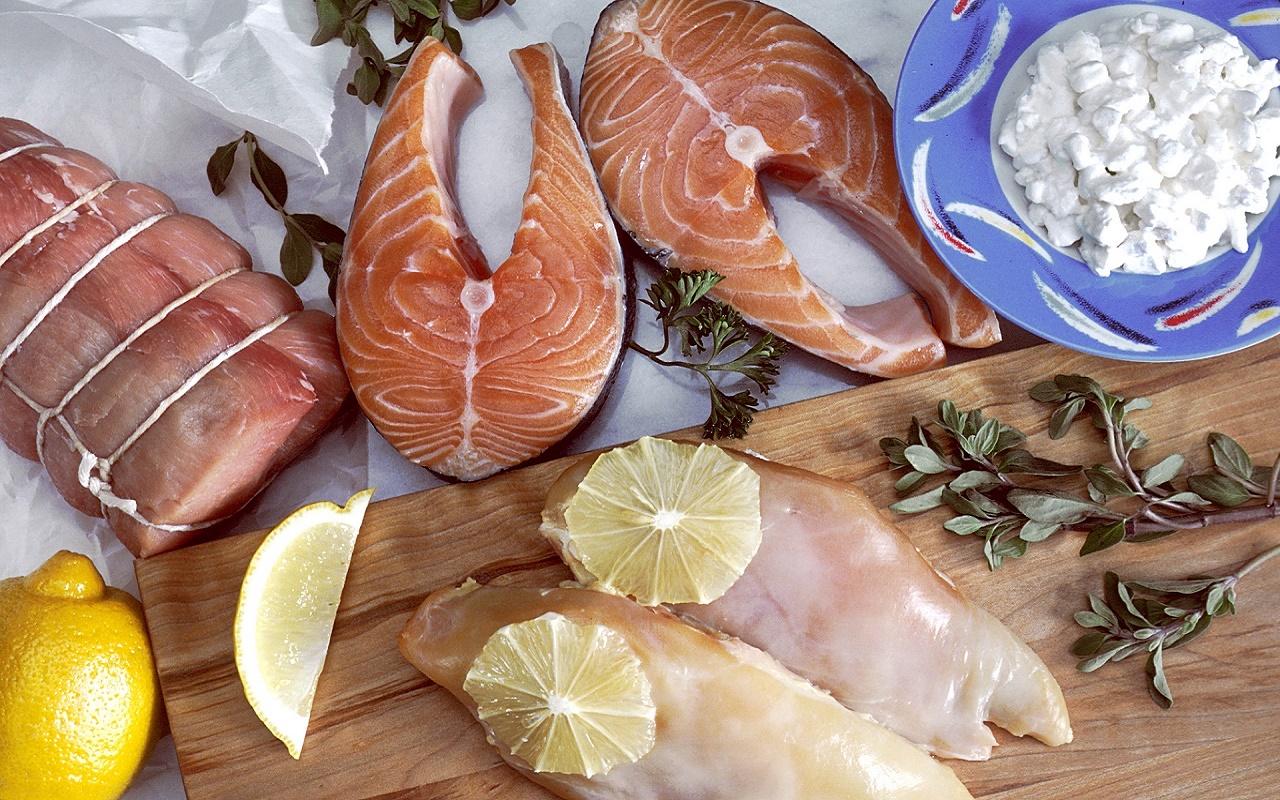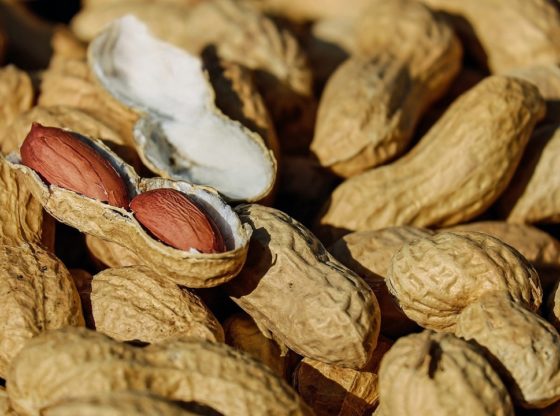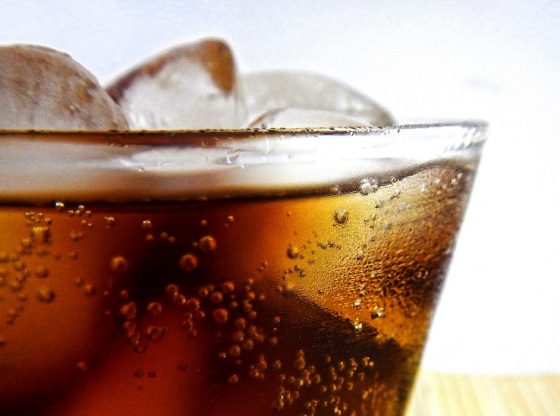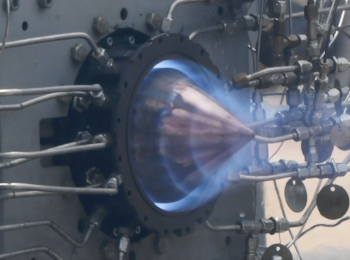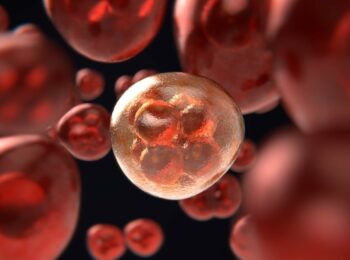Protein is very important. The amount we consume in our diet impacts our health and body directly. We need it to build and repair cells and make healthy muscles, organs, glands, and skin. Everyone needs a minimum amount each day, there are however vastly different opinions and data out there on how much protein we actually need.
Most official nutrition organizations recommend a fairly modest protein intake. Defined as a minimum amount required for health, which is described in the current Dietary Reference Intakes (DRI), by the terms estimated average requirement (EAR) and recommended dietary allowance (RDA) – often seen on the nutrition facts label on food as a percentage of value.
The World Health Organization Committee estimated mean protein requirements as 0.66 grams of protein per kilogram of body weight (g/(kg·day)) with a population requirement of 0.8 g/(kg·day), based on nitrogen balance data (more on that later). The Institute of Medicine recommends 0.8 g/(kg·day).
The RDA is certainly a “nice” minimum threshold to fend off deficiency but it is not in any form an optimal value, as current scientific evidence shows. It is intended to cover minimum protein needs for 97.5% of the healthy population. But the question, what is optimal, does instead depend on who you are and what you want to achieve.
Athletes and people who want to improve their physical performance do not abide with RDA as their needs are greater. They will achieve much better results with more protein than what RDA would imply.
Present recommendations for athletes are significantly higher. Scientific research on the topic is still ongoing and as new data continue to emerge – science is constantly changing as it should – we are getting an ever more complete picture. Even so, the differences in recommendations are negligible for most, but somewhere between 1,6 to 1,8 g/(kg·day) are most common, with endurance athletes needing a little less than weight-training athletes.
North American adult protein intakes presently average 16% of energy (1.68 g/(kg·day)) and range up to 23% of energy (2.4 g/(kg·day)), derived from the United States Department of Agriculture (USDA).
The Research: Nitrogen Balance
Until quite recently, protein and amino acid requirements were determined using nitrogen balance (namely food nitrogen intake minus nitrogen excreted). Nitrogen balance is, however, a notoriously unreliable method to assess changes in lean body mass, especially at higher amounts of protein, and most studies don’t control for sweating or dietary adaptation. Significant changes in dietary protein intake are known to result in negative nitrogen balance for up to 2 weeks after the change, even when sufficient energy and protein is consumed and a minimum of 3 days is needed per level of test intake and 7–10 days of adaptation are needed to each intake of protein or amino acid. Complete collection and quantification of all sources of nitrogen excretion (mostly in urine and feces) are difficult. There is, however, a new more accurate method called IAAO, more on that method later.
Several review papers have concluded that 1,80 g/kg (0.82g/lb) is the upper limit at which protein intake benefits body composition (Phillips & Van Loon, 2011). This recommendation often includes a double 95% confidence level.
Lemon et al. (1992) studied bodybuilders who were exercising hard, 1.5 hours per day, 6 days per week, and concluded that 1,65 /(kg·day) (0.75g/lb) is the highest intake at which body composition benefits occur.
Pikosky et al. (2008) took a group of endurance-trained athletes and had them consume either 0,9 or 1,8 g/kg (0.41 or 0.82 g/lb) of protein per day. With a thousand calories worth of training added on top of their regular exercise, they were on a 1000 calorie deficit with a drastically increased training volume. The nitrogen balance in the low protein group plummeted. The protein intake of 1,8 g/(kg·day) (0.82/lb) protected the other group completely from muscle loss. Nitrogen balance, whole-body protein turnover, and protein synthesis remained unchanged.
Then there are those dubious studies sponsored by supplement companies, who – naturally – have an obvious financial incentive to make you want to believe you need more protein than you really do.
The Research: IAAO
A very recent review study (published in 2016) by Paul B. Pencharz, Rajavel Elango, and Robert R. Wolfe sheds new light on the topic. It is a broad review of studies using the newer and alternative method IAAO ( an indicator of amino acid oxidation) instead of the older nitrogen balance method. This method analyses the amount of carbon dioxide in your breath to determine protein requirement and is regarded as more accurate and effective.
The authors conclude:
Current evidence indicates that most adults will benefit from intakes above the RDA of 0.8 g protein/(kg·day).
There are no known adverse effects of this level of protein intake in normal individuals (Institute of Medicine 2005; Phillips et al. 2016).
Therefore, we propose that in practice, 1.5–2.2 g/(kg·day) constitutes a reasonable recommendation for the amount of protein that should be eaten by adults as part of a complete diet
Food or Supplements?
To achieve this amount of protein per day is probably not difficult for most eating a healthy regular diet. Since athletes are already consuming more calories per day anyway, this should not be an impossible task. But depending on your weight, appetite and personal preferences, it can be difficult to reach the optimal level of protein for some. The recommendation is to eat more protein-rich foods or make use of any kind of protein supplement.
There is an ongoing debate about dietary supplements and it is often argued that “protein supplements are not needed when eating a balanced healthy diet”. Present scientific data do not provide evidence that protein powder or any other form of amino acid supplements really have any additional advantage for athletes when the total protein intake is high enough anyway.
There are however theoretical advantages of these supplements, Essential Amino Acids (EAA) and Branched Chain Amino Acids (BCAA), in correlation with workout sessions, as increased protein synthesis have been seen. Protein synthesis is described by the basic equation for muscle mass: muscle mass = rate of protein synthesis – rate of protein breakdown. Both exercise and BCAA/EAA appears to stimulate the important signaling pathway called mechanistic target of rapamycin (mTOR) which is essential for protein synthesis (Moberg et al. 2016). No data exists however if this makes any real difference in practice in the long run.
Studies looking at the effect of protein supplements (whey) in association with weight training has indicated an increased response in training results when not also checked for control group total protein intake (Cermak et al. 2012 and Schoenfeld et al. 2013).
So if you are not actively trying to eat extra protein and want to make sure that you indeed reach your target amount of protein per day, protein powder can be a practical way to increase protein intake and thereby get slightly better training results.
Loosing Weight and Gaining Weight
The importance of adequate dietary protein is most relevant for those who are on a calorie deficit and trying to lose weight. As mentioned above, several studies indicate a great advantage of a higher protein intake to protect and maintain muscle mass. This applies to both strengthening athletes and endurance athletes. More protein will give you a better effect of your dieting when cutting calories by retaining more of your muscle mass (Paddon-Jones D 2008). Indeed, there are some researchers who suggest that up to 2,3 to 3 g/kg may be beneficial (Helms 2013).
Since when trying to lose weight you often eat less food and calories than normal, this means that if you do not change your diet to relatively more protein – this will cause your relative actual protein intake in grams to decrease as well. You will thus eat less protein than normal in a situation when you need more protein than normal.
It is sometimes claimed that extra protein in the form of protein supplements increases your risk of gaining weight since you eat more calories. This is a possible hypothesis, but no studies that have investigated the effects of protein supplements for athletes have seen any effect on their fat mass. Fact is that not all calories are the same and protein “costs” more for the body to convert into energy than carbohydrates or fat.
So, protein takes more energy for you to digest than refined carbohydrates or fat, and also gives your body an increased feeling of satiety.
The Elderly
You might think that you need less protein as you age, and yes you would be correct in one way. Scientific evidence indicates that the more experienced you are as an athlete, the less protein you need, has been replicated in several studies (Rennie & Tipton, 2000; Hartman, Moore & Phillips, 2006; Moore et al., 2007) and the more years you have been training usually translates into age.
But if considering the population as a whole, age does not imply a decrease in protein need. In fact, if you are an elderly person who is weight training, you also need more protein to help and speed up your body recovering (Moore et al. 2014 and Breen et al. 2011).
A common problem for the elderly is probably that protein-rich foods generally saturates better than less protein-rich food and many older people generally eat less as they often also have a low energy intake in general. This situation could probably result in a vicious circle for many elderly, women especially, who are less active also eat less, making them nutrient deficient and slightly malnourished, resulting in them becoming even less active and more receptive to diseases.
The Pregnant and Growing Child
During pregnancy, protein needs are different depending on the stage of gestation, with early stages requiring 1.2 g/(kg·day) and later stages of pregnancy requiring 1.5 g/(kg·day) (Stephens et al. 2015). A a mean protein requirement of 1.3 g/(kg·day) has been reported in preadolescent school-aged children (Elango et al. 2011).
Conclusion
There is good reason for people who exercise, especially those weight training buffs, to eat more protein than the current recommendations for the common man. But with that said, it is often not a problem for those who exercise to reach the levels that seem to be required for maximum impact by simply changing the diet to include a little more protein-rich foods – as they eat more food anyway.
Weight loss is a whole different animal entirely, it is not only more difficult to reach an adequate protein intake as you often eat less to achieve a calorie deficit necessary to lose weight. It has been shown in several studies that additional protein keeps your body from breaking down muscle tissue. Protein also makes you fuller, making it easier to eat less.
If you eat enough dietary protein through regular food, you likely do not need the extra protein from protein supplements, but if you do use it, you will at best see a minimal effect. The vast majority of athletes who are not actively trying to eat more protein foods don’t. Does who would benefit the most from protein shakes are, perhaps a bit contradictory, the elderly, with little or no appetite.
A caveat here is that more protein isn’t better if the sources of protein aren’t healthy. Indeed, there is a good idea to choose the most healthful sources of protein and avoid highly processed foods. And to eat a balanced and nutritious diet in general, with good carbohydrates as needed, good fats, fresh fruits, and vegetables.
_______________
Phillips SM, Van Loon LJ. J Sports Sci. 2011 Dietary protein for athletes: From requirements to optimum adaptation. ;29 Suppl 1:S29-38.
Lemon PW, Tarnopolsky MA, MacDougall JD, Atkinson SA. J Appl Physiol. 1992 Protein requirements and muscle mass/strength changes during intensive training in novice bodybuilders. Aug;73(2):767-75.
Pikosky MA, Smith TJ, Grediagin A, Castaneda-Sceppa C, Byerley L, Glickman EL, Young AJ. Med Sci Sports Exerc. 2008 Increased protein maintains nitrogen balance during exercise-induced energy deficit. Mar;40(3):505-12.
Paul B. Pencharz, Rajavel Elango, and Robert R. Wolfe, 2016 Recent developments in understanding protein needs – How much and what kind should we eat? Applied Physiology, Nutrition, and Metabolism, NRC Research Press
Institute of Medicine. 2005. Dietary Reference Intakes for Energy, Carbohydrates, Fiber, Fat, Protein and Amino Acids (Macronutrients). The National Academies Press, Washington, DC, USA
Phillips, S.M., Chevalier, S., and Leidy, H.J. 2016. Protein “requirements” beyond the RDA: implications for optimizing health. Appl. Physiol. Nutr. Metab. 41(5): This issue. doi:10.1139/apnm-2015-0550. PMID:26960445.
Cermak NM. Am J Clin Nutr. 2012 Protein supplementation augments the adaptive response of skeletal muscle to resistance-type exercise training: a meta-analysis. Dec;96(6):1454-64.
Schoenfeld BJ. J Int Soc Sports Nutr. 2013 The effect of protein timing on muscle strength and hypertrophy: a meta-analysis. Dec 3;10(1):53
Paddon-Jones D. Am J Clin Nutr. 2008 Protein, weight management, and satiety. May;87(5):1558S-1561S.
Helms ER, Zinn C, Rowlands DS, Brown SR. Int J Sport Nutr Exerc Metab. 2013 A Systematic Review of Dietary Protein During Caloric Restriction in Resistance Trained Lean Athletes: A Case for Higher Intakes.
Rennie MJ, Tipton KD. Annu Rev Nutr. 2000 Protein and amino acid metabolism during and after exercise and the effects of nutrition.;20:457-83.
Hartman, J. W., Moore, D. R., & Phillips, S. M. 2006. Resistance training reduces whole-body protein turnover and improves net protein retention in untrained young males. Applied Physiology, Nutrition and Metabolism, 31, 557–564.
Moore, D. R., Del Bel, N. C., Nizi, K. I., Hartman, J. W., Tang, J. E., Armstrong, D. et al. 2007 Resistance training reduces fasted- and fed-state leucine turnover and increases dietary nitrogen retention in previously untrained young men. Journal of Nutrition, 137, 985–991.
Bauer J. J Am Med Dir Assoc. 2013 Evidence-based recommendations for optimal dietary protein intake in older people: a position paper from the PROT-AGE Study Group. Aug;14(8):542-59
Moore DR. J Gerontol A Biol Sci Med Sci. 2014 Protein ingestion to stimulate myofibrillar protein synthesis requires greater relative protein intakes in healthy older versus younger men. Jul 23
Breen L. Nutr Metab (Lond). 2011 Skeletal muscle protein metabolism in the elderly: Interventions to counteract the ‘anabolic resistance’ of ageing Oct 5;8:68.
Stephens, T.V., Payne, M., Ball, R.O., Pencharz, P.B., and Elango, R. 2015. Protein requirements of healthy pregnant women during early and late gestation are higher than current recommendations. J. Nutr. 145(1): 73–78. doi:10.3945/jn. 114.198622. PMID:25527661.
Elango, R., Humayun, M.A., Ball, R.O., and Pencharz, P.B. 2011. Protein requirement of healthy school-age children determined by the indicator amino acidoxidation method. Am. J
Moberg M1, Apró W2, Ekblom B2, van Hall G3, Holmberg HC4, Blomstrand E5. 2016 Activation of mTORC1 by leucine is potentiated by branched-chain amino acids and even more so by essential amino acids following resistance exercise.
Institute of Medicine, Dietary Reference Intakes for Energy, Carbohydrate, Fiber, Fat, Fatty Acids, Cholesterol, Protein, and Amino Acids (Macronutrients) (2005)
______________________________

